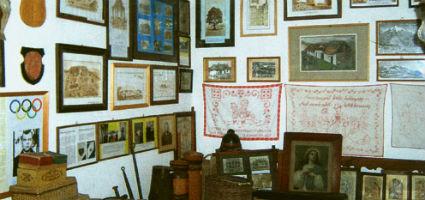2024. April 26. Friday
Village House - Márianosztra
 |
Address: 2629, Márianosztra Miklós u. 2.
Phone number: (27) 370-496
E-mail: nosztrafaluhaz@freemail.hu
Opening hours: On prior notice
|
20 June 1998 is a significant date in the life of the town. This is when one of the houses in the village was turned into the 'Village House'. Why was this decision made? Why was this particular house chosen? Why then? Where were the documents and objects about the past of the village? And a lot more questions come up to those who are pondering about the values of the past 700 years.
There were many who realized the importance of ethnographic values and began collecting material. The old people said that people from the towns often came and bought old spinning machines, fibre, chests etc for almost nothing. They old people were happy to sell them. People of villages were always happy to rejoice anybody. They were thus happy to give away anything they could not use anymore.
Who would use the spinning machine when textile can be bought in the shops and not so expensive. From the 1960’s modern and colorful things were all over the kitchens, of course, made of plastic. Often, old objects reminded the owners of the poverty of the past.
Luckily, the stories of the old was often recorded by young ethnographers. They decided to save whatever they could. So they did everything to preserve as much as they could. All the material collected had to be kept somewhere where the works of the old masters could be seen along with photos and yellow documents. The oldest buildings and often the worst in state in Márianosztra are often in the center of the town.
An unoccupied building stood at 2 Miklós Street. We did not know the year it was built in. It was almost a complete ruin when the Self-government of the town decided to buy it and create a village house there. Many could not put belief in it. Village House, they asked, Village Museum? In this ruin? And who is going to work there? What will be in it?
Schottner Miklós and Tasnádi György believed in the plan from the very beginning. They began to reconstruct the building. Then, the first objects arrived. Carved furniture, ricer tools, pottery, embroidery etc.
Now three wards are open with objects along with exact description of them. Entering the house, the visitors can see an old kitchen. Two rooms open from there. In one, memoirs of old professions are shown. Names of families that moved to the town in the 1600’s and 1700’s reads on the signs: Bezeczky, Zelenay, Domaniczky, Jancsikovszky. Polish names. They probably arrived with copies of the Czestochowa Madonna.
Entering the other room, the visitors can see photos, embroidery, documents and seals in showcases. In between the two wall, a stove heats the rooms.
In the yard, and exhibition on the stone mining of the Hills of Börzsöny is open. The beautiful vine press is also located in the yard. Saved parts of the watermill are also shown on the yard. The old grindstones and other parts give an insight into the work of our ancestors.
There were many who realized the importance of ethnographic values and began collecting material. The old people said that people from the towns often came and bought old spinning machines, fibre, chests etc for almost nothing. They old people were happy to sell them. People of villages were always happy to rejoice anybody. They were thus happy to give away anything they could not use anymore.
Who would use the spinning machine when textile can be bought in the shops and not so expensive. From the 1960’s modern and colorful things were all over the kitchens, of course, made of plastic. Often, old objects reminded the owners of the poverty of the past.
Luckily, the stories of the old was often recorded by young ethnographers. They decided to save whatever they could. So they did everything to preserve as much as they could. All the material collected had to be kept somewhere where the works of the old masters could be seen along with photos and yellow documents. The oldest buildings and often the worst in state in Márianosztra are often in the center of the town.
An unoccupied building stood at 2 Miklós Street. We did not know the year it was built in. It was almost a complete ruin when the Self-government of the town decided to buy it and create a village house there. Many could not put belief in it. Village House, they asked, Village Museum? In this ruin? And who is going to work there? What will be in it?
Schottner Miklós and Tasnádi György believed in the plan from the very beginning. They began to reconstruct the building. Then, the first objects arrived. Carved furniture, ricer tools, pottery, embroidery etc.
Now three wards are open with objects along with exact description of them. Entering the house, the visitors can see an old kitchen. Two rooms open from there. In one, memoirs of old professions are shown. Names of families that moved to the town in the 1600’s and 1700’s reads on the signs: Bezeczky, Zelenay, Domaniczky, Jancsikovszky. Polish names. They probably arrived with copies of the Czestochowa Madonna.
Entering the other room, the visitors can see photos, embroidery, documents and seals in showcases. In between the two wall, a stove heats the rooms.
In the yard, and exhibition on the stone mining of the Hills of Börzsöny is open. The beautiful vine press is also located in the yard. Saved parts of the watermill are also shown on the yard. The old grindstones and other parts give an insight into the work of our ancestors.